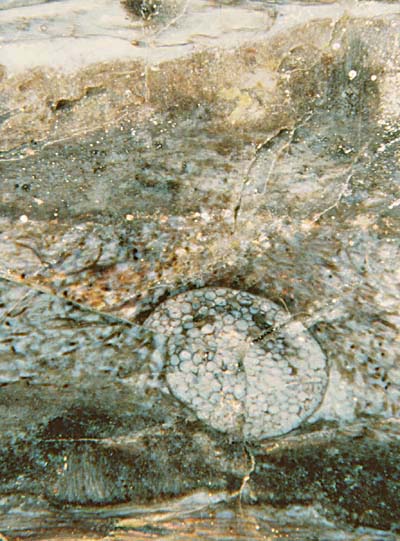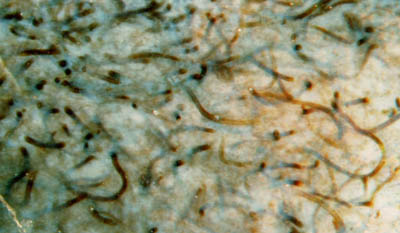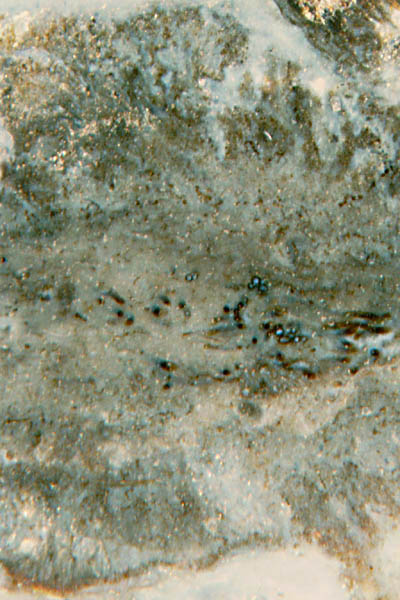A flat nematophyte from Rhynie
Nematophyton taiti (also spelt taitii), the first
of the enigmatic
nematophytes
found in
the Rhynie chert, has remained a very rare fossil since its discovery.
It had been found as two little fragments of about 3mm and 5mm with
different structure [1]. The interpretation as different parts from
one organism was a good guess. From the curved surface of one of the
fragments the authors [1] concluded that the whole organism was
probably cylindrical.
A recent find resembling or representing Nematophyton
taiti can give a clue as to whether this species was
originally flat or
bulky. Its principal structure is evident from
Fig.1 where a tangle or
felt of bigger tubes (Fig.2) is seen sandwiched between layers of
another type. These layers mainly consist of a tangle of vaguely seen
smaller tubes, with aligned bunches of what appears to be a third kind
of tubes, possibly generative ones, ending at the surface, as seen
below left.

Fig.1: Nematophyte section, probably Nematophyton taiti,
penetrated by
an Asteroxylon
root, multiply broken and displaced during
silicification. Note the sandwich structure with a tangle of tubes in
the middle layer and poorly seen smaller tubes above and
below, and a bunch of aligned tubes below left. Height of the picture
3.8mm.

Fig.2: Tangle of curved tubes, 16-24Ám, in the middle layer of
the nematophyte.
The specimen is not well seen as a whole in the chert
because of
displacements before and during silicification. An Asteroxylon root
grown right through the tangle of tubes serves a multiple
purpose here:
It shows that there are deformations of the nematophyte due to contact
with other plants, and it serves an an indicator of fracture in an
advanced state of silicification, with cracks running across the root
and through the nematophyte. Also it proves the absence of overall
compression since the deviation from its circular shape is minimal,
except for the displacement after fracture. The root reveals even more
details: The fragments had been displaced with respect to each other.
There are displacement components perpendicular to the picture plane,
which can be concluded from the aspect of the broken root. Apparently
the cracks healed as the silicification proceeded. Similar distortions
due to contact with plants and to fracture are present elsewhere on the
specimen.
The absence of overall compression can also be deduced from Fig.2,
where the tangle of tubes does not look compressed.
Fig.3 provides an additional argument against compression of a
cylindrical shape into a flat one before silicification: The
inner region with bigger tubes is seen to gradually thin out, which
would not be obtained with an originally cylindrial
region squeezed flat.
Fig.3 (right): Section of nematophyte, probably Nematophyton taiti,
with the inner layer of thicker tubes gradually thinning out and
vanishing near the margin. Note also the sections of thinner tubes seen
as dark dots, and the vaguely seen bunch of aligned tubes below left.
Height of the picture 2.2mm.
So it can be concluded that the specimen was originally flat, about
35mm wide, with thickness of about 4mm which reduces to about 2mm near
the circumference. This supports the assumption that the flat aspect of
the numerous coalified specimens of nematophytes found elsewhere [2] is
not brought about by compression only. This conclusion had been offered
at EPPC 2010 [3].
H.-J. Weiss
2010
[1] R.
Kidston, W.H. Lang : On Old Red Sandstone
plants showing structure ...,
Part V, Trans. Roy. Soc. Edinburgh 52
(1921),
855-902.
[2] P.K.
Strother : Clarification of the genus Nematothallus,
J. Paleont. 67 (1993), 1090-94.
[3] H.-J. Weiss:
Enigmatic Organisms - Insights derived from new
finds,
Poster presentation, EPPC Budapest 2010.
 |
 |
35 |






